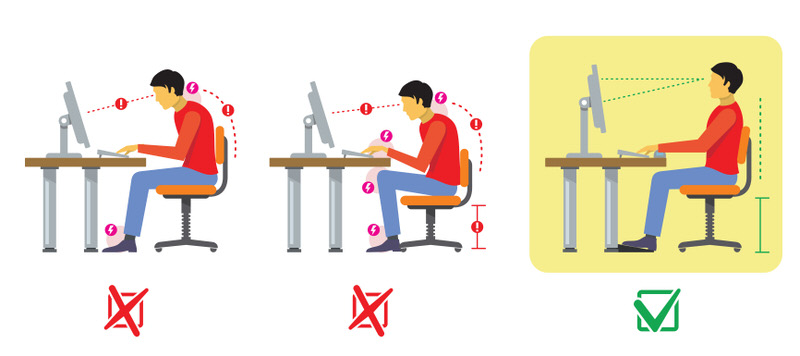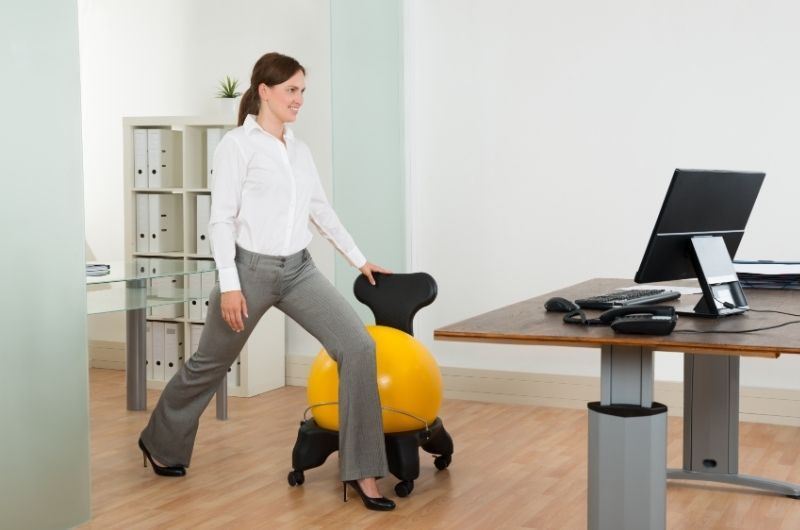Back pain becomes a good friend to most of us as we get older. We have accepted it to be a definite sign of old age, something that simply cannot be avoided.
The current pandemic has most of us working from home, meaning more time spent seated than usual. Out of the blue, your lower back and tailbone hurts when you sit down. But you didn’t even have a recent injury or a fall to justify this pain. You didn’t even do any unusual physical activities. So what does it mean when your tailbone starts to hurt? What can you do to prevent it? Is it serious enough for a visit to the doctor?
Coccydynia, more commonly known as tailbone pain, is usually triggered by a physical injury like a fall. In some cases, the pain might start from riding a bike or even being seated too long. Holding an ice pack to your tailbone can bring immediate relief. But changing your sitting posture and buying an ergonomic chair can go a long way to help reduce the pain.
Your tailbone and why it’s hurting

Before we look into curing or preventing coccyx pain, let’s take a quick look at why your coccyx hurts.
The coccyx is the final piece of your spinal cord and is shaped like a triangle. Coccyx pain can be triggered by slipping, falling, and landing on the buttocks. Sometimes the fall might have occurred a couple of years ago, causing a slight misalignment, which grew with time.
Since the tailbone is connected to your spine via ligaments, its alignment can change. As the ligaments heal, they might do so while the tailbone is aligned incorrectly, leading to coccyx pain that appears over time.
This change in coccyx alignment can cause back pain and misalignments up your spine to the skull.
Preventing coccyx pain
Prevention is better than cure. And the most common cause of coccyx pain is your sitting posture. The way you sit can not only cause the tailbone to misalign, but it can also hurt your spine and posture. Couple that with the fact that we spend most of the day seated, there’s a very good chance you might experience coccyx pain within your lifetime.
The most common method of sitting incorrectly is by slouching your back while sitting, where your back makes a C shape.
Your bodyweight should fall onto your thighs and your buttocks, definitely not your lower back, coccyx, or spine. But when you slouch, this is exactly what happens. Here’s when you should pay attention to the way you are seated.
- When traveling – You might have noticed that your car seats or even airplane seats have a C shape and promote slouching. While this is a very poor seat design, you should pay attention to how you are seated when traveling, especially since your attention is more focused on the road than your posture during travel.
- When on your computer – You might be playing a game, watching a movie, or reading an article; whatever you’re doing, it becomes very easy to slouch your back whenever you reach forward. This C shape posture almost becomes your default posture if you’ve been doing it for some time. Soft surfaces like sofas can cause this to happen while hard chairs are uncomfortable but better for your tailbone.
- When relaxing – After a hard day’s work, the last thing you want to do is to sit up straight. After all, it’s easy to slouch and let the chair provide support rather than sitting up straight, which requires your muscles to support your spine.
It’s very easy to plan on sitting up straighten instead of hunching over, but the truth is that we all tend to slouch after a couple of minutes. So what can we do to prevent this?
The best chairs for your posture
The good news is that you can use these chairs to prevent tailbone problems from ever occurring and treat the coccyx if you already have tailbone pain.
A Ball Chair
This chair is specifically designed to improve your posture and spinal alignment. This chair is a specially designed exercise ball on a chair stand. Sitting on this chair requires balance and muscle stability.
It also has the added advantage of strengthening your core and your legs. After all, it requires some muscle coordination to maintain your balance. However, this chair might be hard to sit on, and most people tend to find it exhausting after some time.
A Hara Chair
Patented by HaraTech, this chair distributes your weight more evenly by using a V-shaped seat instead of a flat seat. The unique structure of this seat takes the pressure off your spine and tailbone entirely. Another unique feature is that the backrest is hollow in the middle, meaning that your spine doesn’t touch the chair at all.
The only con to this chair is that it isn’t very adjustable and doesn’t come in many sizes.
An Ergonomic Chair
These chairs are also specifically designed to support your spine by mimicking the natural shape of your backbone. They have a curve in the backrest, providing lumbar support and stability.
These may be the most comfortable to sit on, considering the above list of chairs, but these chairs are quite expensive.
Managing coccyx pain by customizing your chair

While the above chairs can go a long way in preventing and managing coccyx pain, they can also be expensive and difficult to get ahold of, especially during the current Covid-19 pandemic. So are we supposed to suffer until we manage to get our hands on an ergonomic chair?
Don’t worry. Let’s take a look at how we can build a better chair in the comfort of our own home.
- Add some foam to your chair bottom. Your tailbone problems can begin when your coccyx starts to bear your weight. Having a foam seat helps distribute your weight much more evenly to your legs. This can also make the chair much more comfortable to sit on. The best part is that you can customize the amount of foam to suit your body weight. The thicker the foam, the more weight it can support.
- Use a chair with a short or no backrest. Short seats leave your coccyx hanging. Your spine has less contact with a surface, which, in turn, provides your back muscles to support your spine. This is similar to the Hara Chair, except, of course, much easier to make.
- Sitting on an exercise ball. Remember that big rubber exercise ball you bought but rarely use? Well, now you can use it as a budget ball chair. This forces you to sit up straight to maintain your balance. But since you are using your muscles to maintain your posture, make sure you don’t use this chair for long periods.
- Avoid mesh seats. Mesh does not distribute your weight evenly and can hurt your tailbone. These chairs tend to last longer, so people usually buy them, unaware of the problems they cause in the long run.
- Cut a gap in the middle of your seat. Your tailbone is at the very end of your spine. Having a gap in your seat allows your buttocks to rest on the right and left sides of the seat with a gap in between. Having this space reduces the direct pressure on your coccyx.
These solutions obviously can’t replace an actual ergonomic chair. But they can very well work as a short term fix until you manage to get an actual chair to manage your coccyx. So why not give it a try?
Maintaining proper posture
We’ve looked at which chairs can help prevent and treat coccyx pain. We’ve also looked at how we can make a chair until we can get an ergonomic chair. Now let’s take a quick look at some tips we can follow to remind ourselves to maintain our posture.
Keeping your feet on the ground is very important. If you can’t adjust the chair’s height, use a footrest to ensure that your feet have a solid surface to rest on. When your feet are off the ground, it puts more stress on your tailbone, especially f you start swinging your legs.
Taking deep breaths also help maintain your posture. Try taking a deep breath right now. Did you notice you naturally straighten your spine? It’s tough to slouch and breathe in deeply, so you can use breathing to remind yourself about your posture.
Finally, you can try some stretching exercises made especially for your coccyx, like the one below.
- Lie down on your back.
- Pull one knee towards your chest.
- Gently use your hands to pull it further to your chest.
- Hold this position for a few seconds.
- Repeat with the other leg.
Make sure you avoid any physical activity that might cause more damage to your tailbone. Even running or jumping is not recommended.
Remember, a tailbone takes some time to heal, but if you have tried all of the above and you are still having pain sitting or standing, then it might be time to visit your doctor.
But fear not, a study done by Dr. Lesley Lirette discovered that up to 90% of people with coccyx pain could get rid of the pain without medical treatment. She also concludes that this is a very common condition as more and more people tend to sit down more often than they used to.
Conclusion
Whether you have coccyx pain today or not, it’s never a bad idea to pay attention to your posture. Having back injuries gets more common as we grow older, so it’s a good idea to take care of your spine and coccyx.
While getting an ergonomic chair is recommended, there are many things that you can do at the comfort of your own home which wouldn’t cost you a cent, including making your chair.
The most common problem is that we forget about our posture and return to our default C shape slouch in a few minutes. But you can combat this with a little bit of effort and mindfulness.
After all, your spine and tailbone are an essential part of your body. And speaking from experience, it’s much better to prevent coccyx pain than to get it and treat it.


